| Phylum | Chordata | ||||||||||||||
| Sub-phylum | Vertebrata | ||||||||||||||
| Class | Pisces | ||||||||||||||
| Sub-class | Teleostomi | ||||||||||||||
| Order | Percomorphi | ||||||||||||||
| Family | Centropomidae | ||||||||||||||
| Genus | Lates | ||||||||||||||
| Species | Lates calcarifer (Bloch) | ||||||||||||||
The above is an accepted taxonomic classification of seabass or giant perch. Seabass has been placed under several families by various authors in the past (e.g. the grouper family, Serranidae and family Latidae, etc.) However, Centropomidae is the commonly accepted familya name of this species, and the recognized generic name is Lates. Other names such as Perca, Pseudolates, Holocantrus, Coins, Plectropoma, Latris, and Pleotopomus were also given by various authors who collected the fish specimens from different areas. Bloch (Schneider 1801) stated that Lates calcarifer occured in Japan Sea but named it as Holocentrus calcarifer.
The common local names of this species are listed below:
| Common English name | : | Giant perch, white seabass, silver seaperch, giant perch, palmer, cock-up seabass |
| India | : | Begti, bekti, dangara, voliji, fitadar, todah |
| East Bengal | : | Kora, baor |
| Sri Lanka | : | Modha koliya, keduwa |
| Thailand | : | Pla kapong kao, pla kapong |
| Malaysia | : | Saikap, kakap |
| North Borneo | : | Ikan, salung-sung |
| Vietnam | : | Ca-chem, cavuot |
| Kampuchea | : | Tvey spong |
| Philippines | : | Kakap, apahap, bulgan, salongsong, katuyot, matang pusa |
| Indonesia | : | Kakap, pelak, petcham, telap |
| Australia and Papua New Guinea | : | Barramundi |
Body elongated, compressed, with deep caudal peduncle. Head pointed, with concave dorsal profile becoming convex in front of dorsal fin. Mouth large, slightly oblique, upper jaw reaching to behind eye; teeth villiform, no canine teeth present. Lower edge of preoperculum with strong spine; operculum with a small spine and with a serrated flap above original of lateral line. Dorsal fin with 7 to 9 spines and 10 to 11 soft rays; a very deep notch almost dividing spiny from soft part of fin; pectoral fin short and rounded; several short, strong serrations above its base; dorsal and anal fins both have scaly sheath. Anal fin round, with three spines and 7–8 soft rays; caudal fin rounded. Scale large ctenoid (rough to touch).
Colour: two phases, either olive brown above with silver sides and belly in marine environment and golden brown in freshwater environment (usually juveniles). Blue-green or greyish above and silver below (adult).
Seabass is widely distributed in tropical and sub-tropical areas of the Western Pacific and Indian Ocean, between longitude 50°E - 160°W latitude 24°N – 25°S (Fig. 1). It occurs throughout the northern part of Asia, southward to Queensland (Australia), westward to East Africa (FAO 1974).
Seabass is a euryhaline and catadromous species. Sexually mature fish are found in the river mouths, lakes (e.g. Songkhla lake) or lagoons where the salinity and depth range between 30–32 ppt and 10–15m, respectively. The newly-hatched larvae (15–20 days old or 0.4–0.7cm) are distributed along the coastline of brackishwater estuaries while the 1-cm size larvae can be found in freshwater bodies e.g. rice fields, lakes, etc. (Bhatia and Kungvankij 1971). Under natural condition, seabass grows in freshwate and migrates to more saline water for spawning.
Seabass spends most of its growing period (2–3 years) in freshwater bodies such as rivers and lakes which are connected to the sea. It has a rapid growth rate, often attaining a size of 3–5 kg within 2–3 years. Adult fish (3–4 years) migrate towards the mouth of the river from inland waters into the sea where the salinity ranges between 30–32 ppt for gonadal maturation and subsequent spawning. The fish spawns according to the lunar cycle (usually at the onset of the new moon or the full moon) during late evening (1800–2000 hours) usually in synchrony with the incoming tide. This allows the eggs and the hatchlings to drift into estuaries. Here, larval development takes place after which they migrate further upstream to grow. At present, it is not known whether the spent fish migrates upstream or spends the rest of its life in the marine environment (Fig. 2).
Smith (1965) noted that some fish spend their whole life in freshwater environment where they grow to a length of 65 cm and 19.8 kg body weight. The gonads of such fish are usually undeveloped. In the marine environment, seabass attaining a length of 1.7 m have been recorded in the Indo-Australian region (Weber and Beaufort 1936).
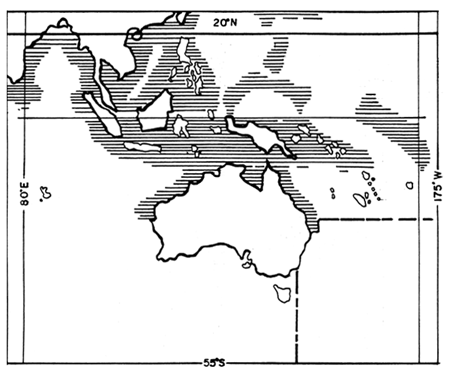
Fig. 1. Geographic distribution of Lates calcarifer. (After FAO 1974)
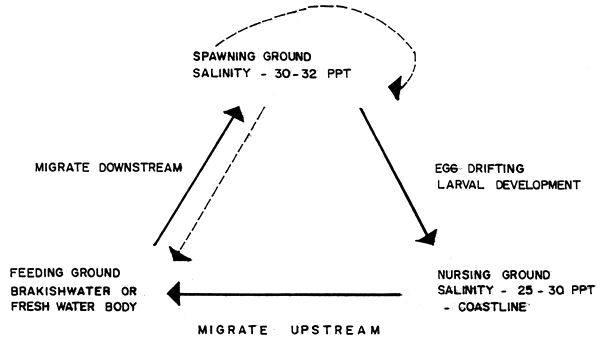
Fig. 2 Migration pattern of Lates calcarifer Bloch
Although the adult seabass is regarded as a voracious carnivore, juveniles are omnivores. Analysis of stomach content of wild specimens (1–10 cm) show that about 20% consists plankton, primarily diatom and algae and the rest are made up to small shrimp, fish, etc. (Kungvankij 1971). Fish of more than 20 cm, the stomach content consists of 100% animal prey: 70% crustaceans (such as shrimp and small crab) and 30% small fishes. The fish species found in the guts at this stage are mainly slipmouths or or pony fish (Leiognatus sp.) and mullets (Mugil sp).
Identification of the sexes is difficult except during the spawning season. There are some dimorphic characters that are indicative of sex (Fig. 3).
Snout of the make fish can be slightly curved while that of the female is atraight.
The male has a more slender body than the female.
Weight of the female is heavier than males of the same size.
The scales near the cloaca of the males are thickers than the female during the spawning season.
During the spawning season, abdomen of the female is relatively more bulging than the males.
In the early life stages (1.5–2.5 kg body weight) majority of the seabass appear to be male but when they attain a body weight of 4–6 kg majority become female. After culture period of 3–4 years, however, in the same age group of seabass both sexes can be found and identified as mentioned above. In a fully mature female, the diameter of the oocysts usually range from 0.4 ro 0.5 mm.
The fecundity of seabass is related to the size and weight of the fish. Gonad samples obtained from 18 females of body weight ranging from 5.5 to 11 kg gave a range of 2.1 to 7.1 million eggs (Wongsomnuk and Maneewongsa 1976) as illustrated in Table 1. Observations by the Australian Department of Agriculture (Anon. 1975) showed that a 12 kg fish had 7.5 million eggs; a 19 kg fish 8.5 million and a 22 kg. fish, 17 million.
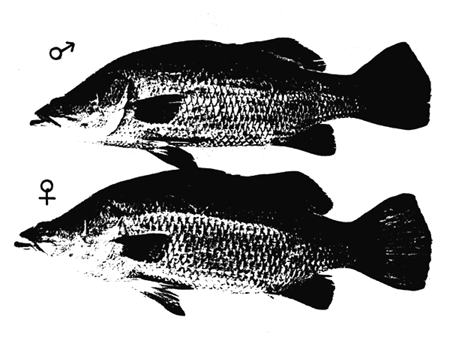
Figure 3 Photograph of adult male and female seabass
| Total length (cm) | Weight | No. of fish | Fecundity (million eggs) | |
| Range | Average | |||
| 70 – 75 | 5.5 | 3 | 2.7 – 3.3 | 3.1 |
| 76 – 80 | 8.1 | 5 | 2.1 – 3.8 | 3.2 |
| 81 – 85 | 9.1 | 4 | 5.8 – 8.1 | 7.2 |
| 86 – 90 | 10.5 | 3 | 7.9 – 8.3 | 8.1 |
| 91 – 95 | 11.0 | 3 | 4.8 – 7.1 | 5.9 |
Seabass spawn all year round (Kungvankij 1984) with the peak season occuring during April-August and large number of fry (1 cm in size) can be collected during May to August (Bhatia and Kungvankij 1971).
Based on studies of spawning activity under tank conditions, mature male and female fish separate from the school and cease feeding about a week prior to spawning. As the female attains full maturity, there ia an increase in play activity with the male. The ripe male and female then swim together more frequently near the water surface as spawning time approaches. The fish spawns repeatedly in batches for 7 days. Spawning occurs during late evening (1800–2200 hours).
First cleavage occurs 35 minutes after fertilization. Cell division continues every 15 to 25 minutes and the egg develop to the multi-celled stage within 3 hours. Its development passes through the usual stages: blastula, gastrula, neurola and embryonic stages. Embryonic hear starts to function in about 15 hours and hatching takes place about 18 hours after fertilization at temperatures of 28–30°C and salinities of 30–32 ppt (Table 2, Fig 4a & b).
Newly-hatched larvae have total length ranging from 1.21 to 1.65 mm averaging 1.49 mm. The average yolk sac length is 0.86 mm. One oil globule is located at the anterior part of the yolk sac which causes the hatchling to float almost vertically or about 45° from its usual horizontal position. Initial pigmentation is not uniform; the eyes, digestive tract, cloaca and caudal fin are transparent. Three days after hatching, most of the yolk sac is absorbed and the oil globule diminishes to a negligible size. At this stage, the mouth opens and the jaw begins to move as the larva starts to feed.
Table 2. Embryonic development of seabass eggs (Kungvankij 1981).
| Embryonic stage | Hours & minutes after spawning | |
| Hours | Minutes | |
| Fertilization | - | 5 |
| 2-cell | - | 35 |
| 4-cell | - | 55 |
| 8-cell | 1 | 10 |
| 16-cell | 1 | 30 |
| 32-cell | 1 | 50 |
| 64-cell | 2 | 20 |
| 122-cell | 3 | - |
| Blastula stage | 5 | 3- |
| Gastrula stage | 7 | 00 |
| Neurola stage | 9 | 10 |
| Embryonic stage | 11 | 50 |
| Heart functioning | 15 | 30 |
| Hatch out | 18 | - |
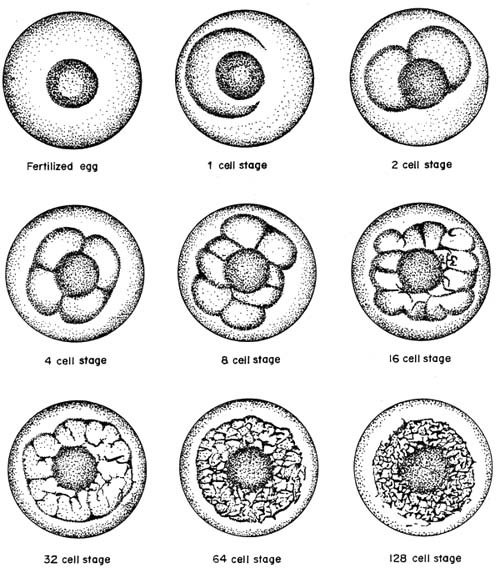
Fig 4a. Development of egg
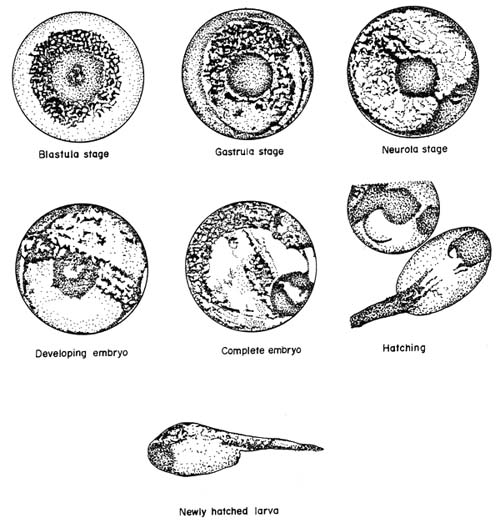
Fig 4b. Development of egg
There are at least two pigmentation stages in seabass larvae. At 10–12 days after hatching, the pigmentation of larvae appears dark gray or black. The second stage occurs between 25–30 days old where the larvae develop into fry. In this stage, the pigmentation changes to a silvery-coloration.
It has been observed that only healthy fry of this stage (20–30 days) swim actively. They are always lighter in color. Unhealthy post larvae have dark or black body coloration.
The growth rate of seabass follows the normal sigmoid curve. It is slow during the initial stages but becomes more rapid when the fish attains 20–30 gm (Table 3). It slows down again when the fish is about 4 kg in weight.
Table 3. Age, average body length and weight of seabass under tank conditions.
| Age (days) | Average length (mm) | Average body weight |
| Fertilized eggs | 0.91 | |
| 0 | 1.49* | |
| 1 | 2.20 | |
| 7 | 3.61 | |
| 14 | 4.35 | |
| 20 | 9.45 | |
| 30 | 13.12 | 0.1 |
| 40 | 17.36 | 0.5 |
| 50 | 28.92 | 1.2 |
| 60 | 32.85 | 3.5 |
| 90 | 93 | 9 |
| 120 | 145 | 50 |
| 150 | 210 | 120 |
| 180 | 245 | 280 |
| 210 | 310 | 330 |